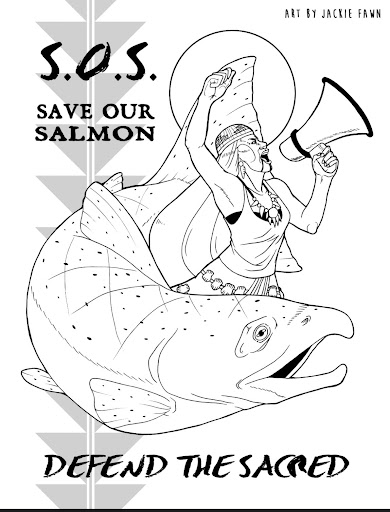Overview
Activism: Land Back

Authors and Contributors:
Phil Albers (Karuk) Education Director Save California Salmon
River Burkhart (Sisseton Wahpeton/Cherokee/Choctaw)
Save California Salmon (SCS) is dedicated to policy change and community advocacy for Northern California’s salmon and fish dependent people. We support the fisheries and water protection work of the local communities, and advocate effective policy change for clean water, restored fisheries and vibrant communities.
Maggie Peters (Yurok/Karuk), NASMC Learning Specialists Humboldt County Office of Education
Grades: 6-8 (middle school)
Suggested Amount of Time: Three 60 minute sessions
Curriculum Themes
- History
- Cultural Strengths
- Law/Government
- Relationship to Place
Learning Goals
- Recognize Indigenous peoples’ cultural and spiritual connections to land
- Analyze the impacts of colonization, missions, and residential schools on Indigenous communities
- Learn about historical and current movements for land justice (e.g., Land Back, Alcatraz Occupation, Tuluwat Island)
- Examine legal and community efforts to reclaim and protect Indigenous lands
- Reflect on the importance of tribal sovereignty, cultural revitalization, and environmental care
- Acknowledge ancestral lands and consider our role in supporting Indigenous rights
Lesson Overview
The relationship between Indigenous peoples and land in the U.S. is deeply rooted in cultural, ceremonial, and historical connections, which have often been disrupted by colonization, forced assimilation, and land dispossession. Concepts such as Tribal sovereignty, land stewardship, and land back movements emphasize Indigenous peoples’ inherent right to govern themselves, care for ancestral lands, and reclaim access to natural resources. These efforts are grounded in values of cultural revitalization, environmental conservation, and self-determination, often in contrast to policies like land acquisition through unratified treaties, residential schools, and the use of public lands for military, resource extraction, or restricted conservation purposes.
Historical injustices, such as the massacre on Tuluwat Island, the forced assimilation of Native children in residential schools, and the federal repurposing of sacred sites like Alcatraz Island and areas threatened by projects like the GO Road, have fueled calls for justice, education, and reparation. The designation of wilderness areas and environmental laws, while protective in intent, can restrict Indigenous access to traditional lands. Today, Indigenous-led movements continue to advocate for recognition, access, and stewardship of land, as seen through acts of resistance, like the Occupation of Alcatraz, and collaborative efforts, such as the return of Tuluwat Island — a historic step towards acknowledging Indigenous rights and healing generational trauma.
Teacher Background
When teaching about Native American activism, land return, and the ongoing struggle for sovereignty, it is important to approach the content with care, accuracy, and a deep respect for Indigenous voices. This lesson centers on three key case studies—the 1969 Occupation of Alcatraz, the Supreme Court case over the proposed Gasquet-Orleans Road (which would have cut through tribes regional to the lands sacred lands), and the 2019 return of Tuluwat Island to the Wiyot Tribe. Each of these stories highlights a broader history of resilience, community organizing, and cultural survival in the face of historic and ongoing oppression.
Teachers should guide students in understanding that these events are part of a living movement to reclaim stolen lands, protect sacred sites, and assert Indigenous self-determination. This lesson addresses complex histories of colonization and genocide, so it is essential to create a classroom environment grounded in empathy and inquiry. Be mindful not to sensationalize trauma; instead, elevate Indigenous leadership and the powerful strategies Native people have and continue to use to reclaim their rights.
Using case studies invites students to examine real examples of Native resistance and legal battles, and to consider the importance of land in Indigenous identity and cultural practices. It’s best practice to emphasize that “land back” is not simply a political slogan, but a deep call for justice, repair, and spiritual and cultural reconnection. Wherever possible, include Native-authored sources, videos, or guest speakers from local tribes. Teach students that Native nations are sovereign governments with long histories of diplomacy and lawmaking.
Encourage students to reflect on the meaning of activism and allyship, and help them understand that Native-led land restoration and cultural resurgence are vital to environmental and social justice movements today. Approaching these lessons with care ensures that students not only learn the historical facts but also grow in understanding of Native resilience, the significance of land, and the strength of Indigenous movements for justice.
Additional information for the implementation of this lesson:
Indigenous Peoples are the original inhabitants of a region, often referring to Native American groups who have lived on the land since long before colonization. They each have distinct cultures, histories, and deep connections to their ancestral lands. Tribes are specific political and cultural groups of Indigenous Peoples in the U.S. Each tribe has its own identity (e.g., the Yurok Tribe, the Navajo Nation) and may or may not have recognition from the U.S. or respective State governments. Tribal Sovereignty is the inherent right of tribes to govern themselves. Indigenous People are strongly connected to their homelands, and the lands they call home. While addressing the content of this lesson, please be aware that some students, and teachers, may experience a trauma response, or effects of Generational Trauma (Generational Trauma: Definition, Symptoms, Treatment). We strongly recommend utilizing a Trauma Informed approach (Practical Guide for Implementing a Trauma-Informed Approach | SAMHSA Library) when facilitating this lesson. Trauma-informed care is a comprehensive approach to providing services that acknowledges the impact of trauma and aims to minimize the risk of re-traumatization.

